History of the theatre: scenic space in Tuscany

The birth of a theatrical literature presupposes, from its very beginnings, the construction of buildings especially suited to performances. The Roman theatres present in Tuscany bear witness to the ancients' refined knowledge of acoustics and perspective. With the resurgence of a Court and upper-class theatre, starting from the 17th century there arose a new concept of scenic space which was to lead to the realisation in Tuscany of some of the earliest examples of modern theatrical building.
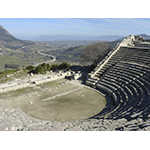
The theatre before the time of Rome
Although ancient sources clearly attest to the existence of an Etruscan theatrical literature, no monumental evidence of a scenic building or space from a time earlier than that of Rome has survived to our own age in the territory of present-day Tuscany. Varro, a learned man from the Augustan Age recalls, for example, the works of a certain Volnius, a writer of tragedies in the Etruscan language, who is thought to have taken as model the coeval production of the Greek world. Only by hypothesis is it possible to imagine that the theatre in Etruria imitated, even from an architectural and structural point of view, the Hellenic models. The latter had been evolving in an architectural form that may be considered completed already by the end of the 5th century B.C.
In Greece the theatrical edifice, in its mature form, was composed mainly of three elements: the cavea or koilon, the stage or skené and the orchestra. The first term identified the semicircular basin with tiered steps following the slope of a hill, where the audience sat. The stage, the place where the theatrical action unfolded, evolved from a simple curtain (and this, in fact, is the original meaning of the Greek word skené) to an architectural façade with three doors opening in it. Lastly, the orchestra, a circular space situated between the cavea and the stage, has lateral access doors (parodoi) and was destined to the action of the chorus. The theatre was open to the sky and could make use, in realising spectacular effects, of machines to lift the actors (mechané), sliding platforms (ekkúklema), and devices of various kinds, such as those for simulating lightening and thunder (keraunoskopeîon and bronteîon).
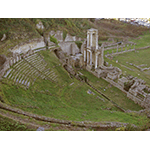
The Roman theatre
As compared to the Greek model, the ancient Roman theatre presented some architectural variations due to changes in the scenic representations which already Vitruvius, in Book V of his work De Architectura, had identified with the utmost precision. Specifically, the space destined to the orchestra was greatly reduced due to the progressively less important place of the chorus in the economy of the performance. The ancient skené was transformed into an imposing stage front on several levels (scaena frons), embellished with marble statues and decorations, whose height, the same as that of the cavea, made it possible to fasten to it, when required, a great tarpaulin (velarium) to cover the theatre. Access to the cavea, which according to Vitruvius contained resounding vessels made of bronze (echeia) to improve the acoustics, was through the openings of the vomitoria. The furnishings were completed by a high stage (pulpitum) and a curtain (unknown to the Greeks) that was dropped at the beginning of the performance. The use of machines borrowed from the Greek world, as well as revolving triangular prisms for changing scenes (periaktoi), is mentioned not only by the architect of the Augustan Age but also by a later author, Pollux, who lived in the 2 nd century A.D. But where the most significant innovations emerged was in the case of the theatres known as exaggerata, a term that indicated buildings constructed on artificial substructures consisting of superimposed vaulted galleries. The achievements attained by Roman engineering allowed in fact, thanks to the use of the arch and of mortar, the realisation of grandiose theatrical auditoriums even on level ground, making it possible for the first time to insert a theatre into the regular urban grid of a city.
As regards Tuscany, the most ancient testimony to theatrical buildings is not found before the 1 st century B.C., and relates to the urban initiatives carried out in Roman times in the ancient Etruscan centres (such as Fiesole and Volterra ) and in the newly founded cities (Florence and Lucca). Reasons of economic nature, along with the characteristic morphologies of many Etruscan localities, made preferable the solution of theatres built by exploiting natural hillside slopes. This is the case of the theatre at Volterra, undoubtedly one of the best conserved, which allows us to appreciate the important structural and architectural differences existing between the Roman theatres and their Greek forerunners.
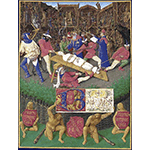
Theatrical space in medieval times
The coming of the Middle Ages marked a decisive change in the concept of theatrical space. The theatrical building "classically" conceived as a place designed for the performance of a play no longer existed. The political and economic crisis of the Western Roman Empire and the condemnation of the Church marked, in fact, the slow decline of the Roman theatre. Medieval performances were now held in a variety of existing places, such as churches, plazas and streets. In particular, for religious dramas held in churches, there existed a number of "delegated places" (mansiones), areas particularly significant from the symbolic viewpoint, at times identified by specially built structures (zafaldi), destined to represent, for example, real places such as mountains or rivers, or places from Biblical stories such as the sepulchre of Christ, the town of Bethlehem, or Paradise. Theatrical machines used to produce special effects were not lacking, while documents from the time testify to the rich costumes and furnishings.
Religious representations and court theatre in Renaissance Tuscany
The medieval tradition of religious representations did not come to an end with the Middle Ages, but handed down its technical and scenic apparatus to the following centuries, thus influencing the theatrical machines of the Baroque Age. For the period ranging from the first half of the 15th century through the first decades of the 16th, there exist precious coeval documents which, although subject to interpretations that occasionally disagree, describe in detail the so-called Florentine "contrivances", whose invention is traditionally attributed to the figures of Filippo Brunelleschi (1377-1446) and of Cecca (1447-1488). These were technical apparatuses and lighting mechanisms utilised for the Annunciation set up, in 1439, in the church of SS. Annunziata (or, according to a recent interpretation, in the church of San Marco), for the annual representation of the Ascension in the church of Santa Maria del Carmine and for the Annunciation of San Felice in Piazza.
Starting from the 15th century, the tradition of religious representations was flanked by the first examples of performances linked to the splendour of the courts and lordly palaces of the time. The fifteenth-sixteenth century reflections on the topics of perspective and the 'myth' of the ideal city, along with the contemporary rediscovery of Vitruvius (whose first printed edition, edited by Sulpicio da Veroli, dates from 1486) contributed to the restoration of the theatre as a unified space in which the stage was designed to be seen perfectly from a single viewing point, occupied by the prince who was patron of the arts. To conceal the presence of increasingly more voluminous stage machinery, Vasari introduced the concept of the back stage area, while Bernardo Buontalenti anticipated the stratagems of the Baroque scene by combining the utilisation of the revolving triangular prisms (the periaktoi of the versatilis stage of Roman memory) with the sliding backdrops of the ductilis scene.
Emblematic of the experimentation of the times are the Olimpico Theatre at Vicenza, the Little Olimpico at Sabbioneta and, for Tuscany, the Medicean Theatre in Florence, the work of Bernardo Buontalenti.
The birth of the modern theatre in the 17th and 18th centuries
The 17th and 18th centuries saw the rise of a new type of theatrical building, the Baroque, or all'italiana, hall, distinguished by an elongated ground plan, originally U-shaped and later horseshoe-shaped, furnished with an imposing, elaborate proscenium and a number of boxes separated by partitions and accessible from independent entrances. This model, which emerged successful after a long period of experimentation that saw the transition from the ancient tiered structure, still present in the Farnese Theatre in Parma, to the mixed plan of the Teatro degli Immobili (later Teatro della Pergola) in Florence, was definitively established in La Scala Theatre of Milan (1778). The unquestioned leaders in this period of change were the members of the Galli Bibiena family, a real dynasty of architects and set designers (from the late 17th to the late 18th century), who interpreted the numerous and heterogeneous tendencies of the age. The advocates, for reasons of acoustics, of buildings with a oval ground plan such as the Teatro dei Rinnovati in Siena, they were the target of criticism from those who saw, instead, theatres with ellipsoidal layout as the concrete expression of the scientific theories formulated on this subject at the time.
As regards the sets and technical apparatus, the 17th century is distinguished by the definitive affirmation of the proscenium as an architectural bearing structure, and the abandonment of the system of periaktoi in favour of flat sliding backdrops, arranged diagonally toward the centre of the scene and actuated by ropes tied to a winch positioned understage. To house the equipment for repertory scenes and the great bulk of machinery, service areas were created, while the stage space was elongated in depth thanks also to skilful optical illusions.
The situation changed in the 18th century. While initially set designs, especially those of the Bibiena, abandoned the central axis and concentrated, with the corner view, on a multi-focus perspective, in the second half of the century the excessive ornamentation of Baroque inspiration was progressively abandoned. The so-called painted scene was widely adopted, which reduced what had been a great perspective machine in the 17th century to the utilisation of a painted canvas for the background along with a few backdrops and drop-curtains. The sets and technical apparatus were simplified, while conserving and developing the mechanisms and stratagems, such as the flies and grooves, which allowed the scene to be changed by raising and lowering drop-curtains from the ceiling.
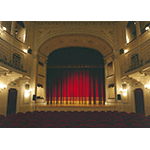
The theatre in the 19th century: continuity and innovation
The 19th century retained basically unchanged the architectural concept of the theatre's ground plan, borrowing from previous centuries the horseshoe-shaped hall all'italiana and the orders of boxes. It was however during this time that innovations of technological nature imparted a strong stimulus to the perfecting of the sets and technical apparatus. In particular, the utilisation of hydraulic energy first and electric power later facilitated the movement of the machines, by now no longer utilised for flight and apotheosis, but above all for moving previously mounted sets onto mobile stages. The new attention to "historic realism" required, in fact, not only meticulous research for theatrical costumes and the frequent presence on the stage of live animals, but also an accurate reconstruction of rooms, now equipped with real ceilings, furnishings and cumbersome objects of daily use that could be easily utilised in changes of scene only if previously mounted on mobile stages concealed to the view of the audience. The effect of realism was, moreover, accentuated by the introduction of new lighting systems. The oil lamps that in the late 18th century had taken the place of the old candlelight, were replaced, from the first half of the 19th century, by gas lights that, in addition to being lit from a distance, made it possible to graduate the brightness of the light during the performance. Lastly, the advent of electric power, already experimented in Paris around the middle of the century but introduced to Italy for the first time only in 1883 at La Scale in Milan, was to revolutionise the concept of scenic space, leading to the progressive abandonment of the painted backdrop.
Numerous are the nineteenth-century theatres of Tuscany, from the Verdi in Pisa to the Metastasio in Prato, from the Castagnoli in Scansano to the Giglio in Lucca (opened in the late 17th century but rebuilt in the early years of the 19th), to the Teatro Pacini in Pescia (it too built at an earlier time but currently appearing in its nineteenth-century version).
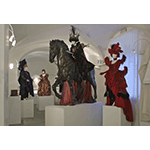
The 20th century: toward a new concept of theatre
It is impossible to reduce to a formula the twentieth-century concept of theatrical space. The ferments that marked the last years of the 19th century, such as Wagner's aspiration to an "opera of total art" or the foundation of Antoine's Théatre Libre, emerged in a context dominated by the new historic avant-garde movements, often torn between a 'primitive' and almost oneiric mode of representing the world and an image of the same tending to exalt the new technological conquests, up to the point of alienating the human element, replaced by marionettes and robots.
Now taking shape with growing clarity was the new role of the director who, especially starting from Craig and Appia, was to confer scenic unity on theatrical pieces thanks to the upgrading of all of its components. Traditional scenography was banned in favour of an ever new and original combination of variously composed plastic elements, often made of innovative materials, and the utilisation of light, experimented in all of its visual and chromatic potentiality, took on a new and central importance.
As regards theatrical buildings there was, on the one hand, a return to the ancient models of the Greek theatre and the Elizabethan theatre which, with the abolition of the proscenium, brought the spectators back to the centre of the space; on the other, to a search for alternative spaces. Exemplary cases were, around the decade of the Thirties, the stage designs for A Midsummer Night's Dream, directed by Max Reinhardt in the Boboli Gardens, and the Representation of Saint Uliva by Jacques Copeau, presented in the cloister of Santa Croce in Florence.
Starting from this period, and even more in the second half of the century, the architects no longer concentrated on designing strictly theatrical buildings, but on constructing multipurpose centres that combined theatrical halls with cinemas, museums, libraries and conference rooms. A significant example is to be found, in Tuscany, in the Rosignano Solvay Theatre, while noteworthy recent initiatives include the creation of the Museo del Teatro, Scenografia e Costume at Bibbiena, ideally connected to the Teatro di Dovizi, and the specialised libraries and little exhibition areas set up on the premises of several historic theatres.
****************************
Texts by Elena Fani
English translation by Catherine Frost
Last update 01/feb/2008


